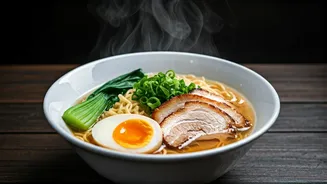Ramen: A Culinary Icon
Ramen has emerged as a globally adored dish, originating from Japan and rapidly spreading its influence across the culinary landscape. Its widespread appeal
can be attributed to its harmonious blend of flavors and textures, with each bowl thoughtfully crafted to provide a memorable dining experience. The essence of ramen lies in its components – the broth, noodles, toppings, and the all-important tare (seasoning). The broth, typically the heart of the dish, can range from rich and creamy tonkotsu to lighter, clearer shoyu. The noodles, which can be straight, wavy, thick, or thin, contribute greatly to the overall enjoyment. Toppings, such as chashu pork, marinated eggs, bamboo shoots, and nori seaweed, are added to complement and enhance the flavor, making each bowl a carefully constructed work of art. The tare, a concentrated seasoning base, ties the entire ensemble together, bringing out the inherent flavors and creating a symphony in every slurp. Understanding these foundational elements is crucial to appreciating the artistry and dedication behind this globally renowned delicacy.
Explore Different Ramen Styles
Ramen is not a one-size-fits-all meal; instead, it showcases an array of regional variations, each boasting distinct characteristics. Firstly, Tonkotsu, a rich and creamy broth crafted from pork bones, is renowned for its decadent flavor, especially popular in Kyushu. Then there is Shoyu, a soy sauce-based broth that is light and slightly sweet. Next up, Shio ramen offers a more subtle flavor, with a clear broth seasoned with salt. Miso ramen is another popular variant, blending miso paste with the broth, creating a savory and complex flavor profile. Curry ramen, a modern twist, integrates Japanese curry into the broth, offering a uniquely flavorful experience. Furthermore, Tsukemen, where the noodles and broth are served separately, allows diners to dip the noodles into the concentrated, flavorful broth. Each style embodies the creativity and adaptability of ramen, making it a dynamic and exciting dish to explore. The breadth of variety ensures that there is a ramen bowl suited for every palate.
Mastering Ramen Components
The preparation of ramen hinges on the precision and quality of its components. The broth is the heart of the dish, taking hours, sometimes even days, to perfect. Broth-making involves simmering various ingredients, typically bones (pork, chicken, or seafood), vegetables, and aromatics, to extract their flavors and create a richly flavored base. The noodles, often made from wheat flour, water, and kansui (an alkaline mineral water), require careful preparation to achieve the ideal texture. The texture of the noodles can range from firm and chewy to soft and tender, depending on the cooking time and the specific style of ramen. The toppings are the final piece, adding depth and complementing the flavor profiles. Chashu pork, marinated eggs, bamboo shoots, and nori are common additions. The tare, the seasoning, is the secret weapon, determining the overall taste. It is essential to ensure a balance of flavors and to consider the interplay between all the elements to achieve ramen perfection.
Top Ramen Destinations
Tokyo stands as a global epicentre for ramen, boasting a plethora of ramen shops, from hole-in-the-wall eateries to Michelin-starred establishments. The vibrant districts of Shinjuku and Shibuya, where each shop showcases its unique style. Osaka is another destination with a strong ramen presence, where the focus lies on rich, flavourful broths and hearty portions. Hakata, in Kyushu, is renowned for its Tonkotsu ramen, with the creamy pork broth dominating the scene. Sapporo, in Hokkaido, is the birthplace of Miso ramen, blending rich miso paste with the creamy broth and adding corn and butter. When you are looking to immerse yourself in the world of ramen, each of these cities offers a unique culinary adventure. Beyond Japan, cities worldwide have their unique ramen scenes, reflecting the popularity and adaptability of this iconic dish.
Ramen Etiquette and Culture
Eating ramen is more than just a meal; it is an experience, infused with cultural nuances. Slurping is a sign of appreciation, allowing one to enjoy the flavours and temperature of the broth. It also helps to aerate the noodles and enhance their flavour. The way chopsticks are held and used are a core part of the dining experience, with specific ways to use them in the process. Finishing the entire bowl is seen as a compliment to the chef, showing your gratitude. Leaving some broth is acceptable, but demonstrating that you have fully savored the dish is usually the goal. Sharing a bowl is less common, with individual bowls considered the norm. A good understanding of this dining etiquette is essential for a respectful and enjoyable experience. Being aware and appreciating these cultural aspects allows you to fully engage with the tradition of ramen.
Ramen at Home: Tips
Making ramen at home is an engaging pursuit, offering a chance to experiment and personalize your bowl. Starting with a quality broth is crucial, and using store-bought broths or creating your own homemade version, by simmering bones and vegetables, are ways to begin. Noodles, either fresh or dried, are available in multiple forms, each lending a unique texture to the final dish. A wide assortment of toppings, such as chashu pork, marinated eggs, and vegetables like bamboo shoots and green onions, allow for diverse flavor combinations. Experimenting with different tare (seasonings), ranging from shoyu (soy sauce) to miso paste, lets you customize the flavour. The key is in mastering each component, balancing flavours, and assembling your perfect bowl. By embracing the process, you can replicate the authenticity of a ramen shop in your own home, delivering a customized and delicious ramen experience.














